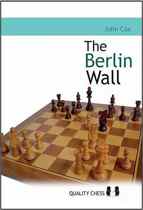Berlin Wall, The
John Cox

The publishing house Quality Chess is aptly named and its latest offering, The Berlin Wall: The Variation That Brought Down Kasparov will only add to its reputation. This is the first book devoted entirely to the sequence 1.e4 e5 2.Nf3 Nc6 3.Bb5 Nf6 4.0-0 Nxe4 5.d4 Nd6, the line Kramnik used to shut down Kasparov in their 2000 title match. Kramniks success has spawned many imitators and this book is chock full of examples of its successful use by 2700 GMs.
Due to the Berlins emphasis on understanding rather than memorization, the model game treatment works especially well here. Cox offers the reader 65 well-annotated games to explain this opening that can be played for a lifetime after the fundamentals are mastered.
To introduce the Berlin the author uses over 1/3(!) of the book to explain the very basics, typical endings and positional themes which are systemically examined. Cox writes effectively and has a knack for clearly explaining things. Chapters 4-9 cover the Berlin proper, Chapter 10 4.d3 and Chapter 11 other tries – 4.Qe2 and more importantly 4.0-0 Nxe4 5.Re1 and 4.0-0 Nxe4 5.d4 Nd6 6.dxe5 Nxb5 7.a4. Cox, who is very objective in his evaluations, points out that while Black has no problems after 7.a4 Nbd4 8.Nxd4 Nxd4 9.Qxd4 d5 10.exd6 Qxd6 11.Qe4+ Qe6 12.Qd4 when 12…Qd6 is best and lead to a draw by repetition in Barrientos-Balogh, Dresden (ol) 2008 theoretically it is hard to avoid splitting the point without taking on undue risk. To his credit, Cox does offers some original suggestions on how to do so. This very small caveat aside, the Berlin is that rare opening that can be played by players spanning a wide span of playing strength. They could ask for no better guide than Coxs book.
Highly recommended.
